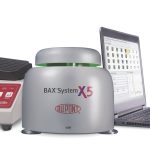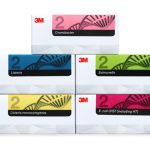In my previous blog, I covered the first two generations of Molecular Diagnostics: Generation one, was the advent of these tests prior to 1995, while the second generation saw the evolution of molecular diagnostics with the emergence of standardized food molecular and method workflow.
The advent of automated DNA sequencing and use of multiple fluorescent dyes by companies like Applied Biosystems and Roche led to the development of multiple fluorescent dyes and real- time quantitative PCR systems (qPCR). At first these qPCR systems were only used in the research environment, but quickly found their way to the food industry.
Applications such as quantitation of GMOs and multiple pathogen targets became common. Real-time PCR systems permitted users to visualize amplification as it happened and enabled simultaneous detection of multiple targets. With the use of newer chemistries and improved enzymes, shorter amplification cycles – sometimes as low as 40 minutes – could be achieved. The real-time systems offered faster time-to-result with additional target probes and thus higher target specificity. As with most molecular methods, the workflow was sensitive to food matrix inhibition and required alternative sample preparation methods to meet the wide variety of food matrixes.
Within this generation of solutions, alternatives were introduced, that promised faster, easier or more sensitive results. These included alternative to either the detection method or enzymes utilized Iisothermal amplification, for example without need for multiplexing capability of qPCR or internal controls, as well as targeting alternative nucleic acid such as RNA were introduced to the food market. These incremental improvements did not lead to any significant new paradigms or improvements to the food testing workflow. Their emergence instead led to an explosion of additional and alternative molecular platforms for food, without any real innovation. Within this, solutions introduced to the food industry eventually brought us to where we are today.
Directly taking systems from the clinical diagnostics workflow and introducing these platforms and systems as food solutions. While these systems automate the entire workflow or automate the PCR setup it remains to be seen if with their higher complexity and high maintenance these systems can survive the food industry. The basic molecular workflow for food has remained intact since its introduction in the late 1990s with innovation more or less stagnant. What’s needed is for someone to truly develop a platform from the ground up with the food laboratory in mind.
Today’s landscape and what’s next
Today, there are some early signals of where innovations and changes for food labs will emerge. A recent poster by Nestle, for example, highlighted the uses of next-generation sequencing (NGS) and DNA sequencing to develop a DNA method to allow the identification of coffee varieties through the value chain, from the field to the finished product. The method is applied on routine basis to guarantee the purity and authenticity of raw material used by Nespresso.
Applications of NGS in outbreak response and trace back investigations are being used in parallel with existing technologies. Finally, availability of new sequencing data enables better assay design and development of adjacent technologies.
NGS was preceded by emulsion amplification and sequencing by synthesis. These developments led to the development and introduction of digital PCR. Within a digital PCR reaction, millions of simultaneous reactions from one sample occur. The advantages of dPCR include lower and absolute, not relative gene copy number. The data has high precision and has better tolerance to inhibitors. These characteristics can lead to better and more precise molecular tests in food. , Before dPCR wide spread adoption is seen, however, the limitations of high cost and limited dynamic range must be addressed.
It’s not only in the testing labs and adjacent technologies that NGS is having an impact. In the labs driving innovation in food and food ingredient development, applications of NGS are being used to develop targeted food ingredients.
Nestle is the leader in this convergence of food, health and nutrition and over the last three years, the company has acquired and formed partnerships targeting the space. In its formation of the Nestle Institute of Health Sciences, Emmanuel Baetge, head of NHIS, emphasized NHIS expertise and research capabilities using systems biology, next generation sequencing, and human genetics.
The world of food safety is as dynamic as the natural flora of food itself. Changing regulations, evolving organisms, technological change and consumers’ changing tastes require new solutions. The requirements of the food laboratory have not changed. They are the protectors of brands and the teams we trust to deliver safe and quality foods. However, how they do that has and will continue to change.
Next time… molecular serotyping.
References:
- Wetterstrand KA. DNA Sequencing Costs: Data from the NHGRI Genome Sequencing Program (GSP) Available at: www.genome.gov/sequencingcosts. Accessed 1/13/2014 [DOA 1/13/12014].
- Beilei Ge and Jianghong Meng , 2009 14: 235 Advanced Technologies for Pathogen and Toxin Detection in Foods: Current Applications and Future Journal of Laboratory Automation DOI: 10.1016/j.jala.2008.12.012.
- Morisset D, Sˇ tebih D, Milavec M, Gruden K, Zˇ el J (2013) Quantitative Analysis of Food and Feed Samples with Droplet Digital PCR. PLoS ONE 8(5):e62583. doi:10.1371/journal.pone.0062583.
- http://www.nestle-nespresso.com/asset-libraries/Related%20documents%20not%20indexed/Nespresso%20poster%20ASIC2012%20DNA%20traceability.pdf







